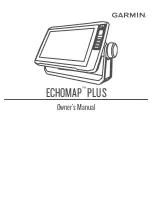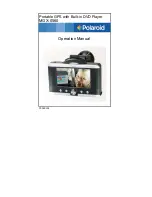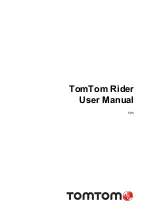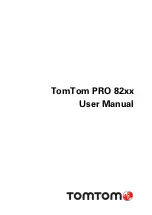
Noise Reject
: Reduces the interference and the amount of
clutter shown on the sonar screen (
).
Appearance
: Configures the appearance of the sonar screen
(
).
Alarms
: Sets sonar alarms (
).
Advanced
: Configures various sonar display and data source
settings (
). Not
applicable to Garmin ClearVü or SideVü sonar views.
Installation
: Configures the transducer (
ClearVü, and SideVü Transducer Installation Settings
).
Setting the Zoom Level on the Sonar Screen
1
From a sonar view, select
Menu
>
Zoom
.
2
Select an option:
• To zoom in on the sonar data from the bottom depth,
select
Bottom Lock
.
• To set the depth range of the magnified area manually,
select
Set Zoom
, select
View Up
or
View Down
to set the
depth range of the magnified area, and select
Zoom In
or
Zoom Out
to increase or decrease the magnification of
the magnified area.
• To set the depth and zoom automatically, select
Set
Zoom
>
Auto
.
• To cancel the zoom, select
No Zoom
.
Setting the Scroll Speed
You can set the rate at which the sonar image moves across the
screen. A higher scroll speed shows more detail, especially
while moving or trolling. A lower scroll speed displays sonar
information on the screen longer. Setting the scroll speed on
one sonar view applies to all the sonar views.
1
From a sonar view, select
Menu
>
Sonar Setup
>
Scroll
Speed
.
2
Select an option:
• To adjust the scroll speed automatically using speed-over-
ground or water speed data, select
Auto
.
The Auto setting selects a scroll rate to match the boat
speed, so targets in the water are drawn with the correct
aspect ratio and appear less distorted. When viewing
Garmin ClearVü or SideVü sonar views, it is recommend
to use the Auto setting.
• To use a very fast scroll speed, select
Ultrascroll®
.
The Ultrascroll option quickly scrolls new sonar data, but
with a reduced image quality. For most situations, the Fast
option provides a good balance between a quickly
scrolling image and targets that are less distorted.
Adjusting the Range of the Depth or Width Scale
You can adjust the range of the depth scale traditional and
Garmin ClearVü sonar views and the range of the width scale
for the SideVü sonar view.
Allowing the device to adjust the range automatically keeps the
bottom within the lower or outer third of the sonar screen, and
can be useful for tracking a bottom that has minimal or moderate
terrain changes.
Manually adjusting the range enables you to view a specified
range, which can be useful for tracking a bottom that has large
terrain changes, such as a drop-offs or cliffs. The bottom can
appear on the screen as long as it appears within the range you
have set.
1
From a sonar view, select
Menu
>
Range
.
2
Select an option:
• To allow the chartplotter to adjust the range automatically,
select
Auto
.
• To increase or decrease the range manually, select
Up
or
Down
.
TIP:
From the sonar screen, you can select or to
manually adjust the range.
TIP:
When viewing multiple sonar screens, you can select
Select to choose the active screen.
Sonar Noise Rejection Settings
From a sonar view, select
Menu
>
Sonar Setup
>
Noise
Reject
.
Interference
: Adjusts the sensitivity to reduce the effects of
interference from nearby sources of noise.
The lowest interference setting that achieves the desired
improvement should be used to remove interference from the
screen. Correcting installation issues that cause noise is the
best way to eliminate interference.
Color Limit
: Hides part of the color palette to help eliminate
fields of weak clutter.
By setting the color limit to the color of the undesired returns,
you can eliminate the display of undesired returns on the
screen.
Smoothing
: Removes noise that is not part of a normal sonar
return, and adjusts the appearance of returns, such as the
bottom.
When smoothing is set to high, more of the low-level noise
remains than when using the interference control, but the
noise is more subdued because of averaging. Smoothing can
remove speckle from the bottom. Smoothing and interference
work well together to eliminate low-level noise. You can
adjust the interference and smoothing settings incrementally
to remove undesirable noise from the display.
Surface Noise
: Hides surface noise to help reduce clutter.
Wider beam widths (lower frequencies) can show more
targets, but can generate more surface noise.
TVG
: Adjusts the time varying gain, which can reduce noise.
This control is best used for situations when you want to
control and suppress clutter or noise near the water surface.
It also allows for the display of targets near the surface that
are otherwise hidden or masked by surface noise.
Sonar Appearance Settings
From a sonar view, select
Menu
>
Sonar Setup
>
Appearance
.
Color
: Sets the color scheme and color gain.
Overlay Data
: Sets the data shown on the sonar screen.
A-Scope
: Displays a vertical flasher along the right side of the
screen that shows instantaneously the range to targets along
a scale.
Depth Line
: Shows a quick-reference depth line.
Edge
: Highlights the strongest signal from the bottom to help
define the hardness or softness of the signal.
Pic. Advance
: Allows the sonar picture to advance faster by
drawing more than one column of data on the screen for
each column of sounder data received. This is especially
helpful when you are using the sounder in deep water,
because the sonar signal takes longer to travel to the water
bottom and back to the transducer.
The 1/1 setting draws one column of information on the
screen per sounder return. The 2/1 setting draws two
columns of information on the screen per sounder return, and
so on for the 4/1 and 8/1 settings.
Sonar Alarms
NOTE:
Not all options are available on all transducers.
From an applicable sonar view, select
Menu
>
Sonar Setup
>
Alarms
.
24
Sonar Fishfinder
Summary of Contents for GPSMAP 8500
Page 1: ...GPSMAP 8000 8500SERIES Owner sManual...
Page 8: ......
Page 66: ...support garmin com October 2017 190 01557 00_0L...














































